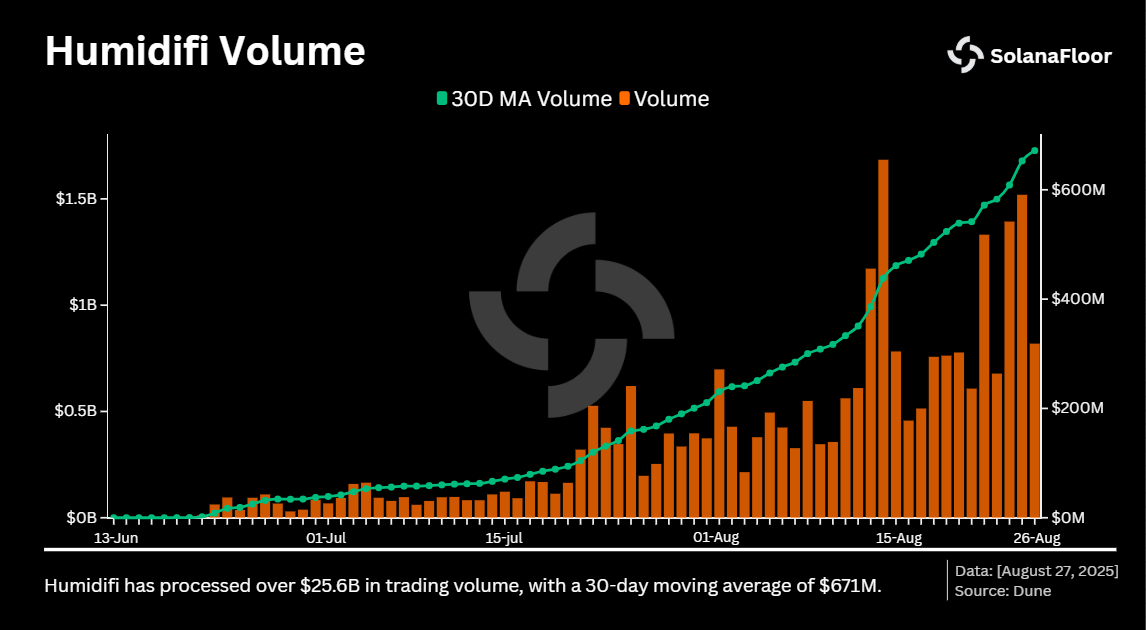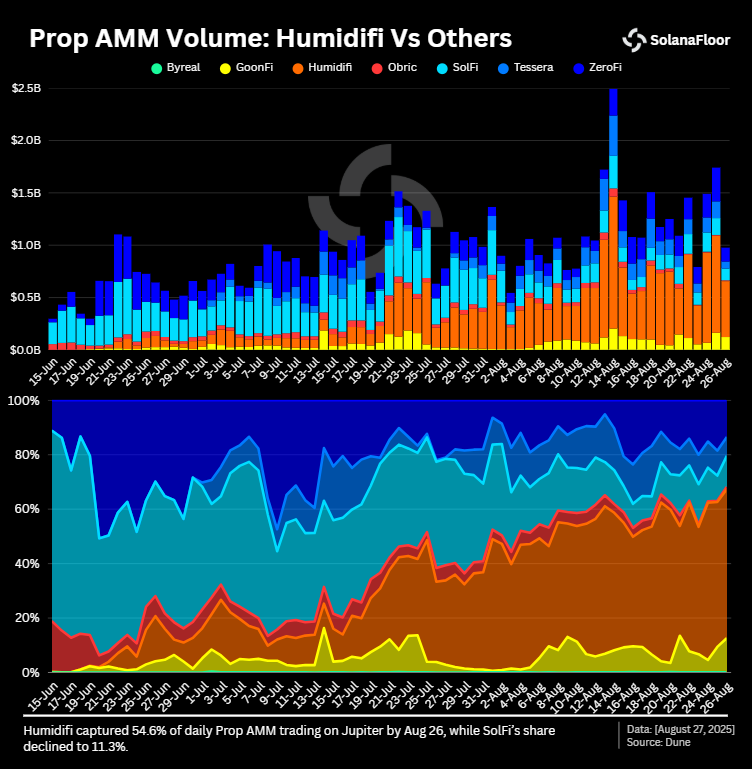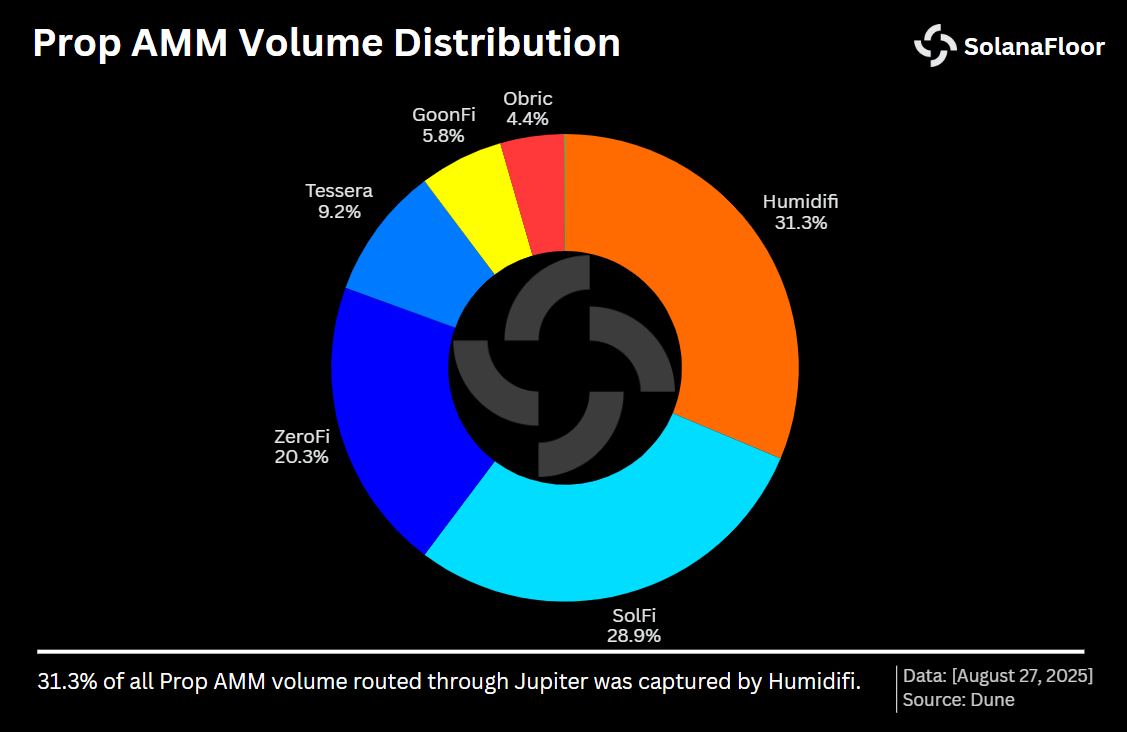
How Humidifi Became a Top Solana DEX by Volume in Under Three Months
In just 74 days, Humidifi overtook established DEXs like Raydium in daily and weekly volume.
- Published:
- Edited:
Prop AMMs, or “Dark AMMs,” are a new kind of DEX on Solana. Unlike traditional AMMs with public liquidity pools, they operate privately, without front ends, and use vault-based liquidity run by a single market maker. Closely tied to Jupiter, Solana’s main aggregator, they deliver tighter spreads and MEV protection, making them increasingly influential in liquid markets like $SOL-USD.
Humidifi’s Rapid Emergence
Humidifi launched only weeks ago and quickly became a major force in Solana’s liquidity markets, showing that efficiency can outweigh longevity.
 According to Dune data, Humidifi processed more than $25.6B in trading volume between June 15 and late August, despite being live for only 74 days. On its busiest day, volume surged to $1.68B, while its 30-day moving average sits at $671M. The bulk of this growth came in the past month, during which Humidifi recorded more than $19.7B in trading activity. Its most recent 24-hour volume exceeded $819M, enough to surpass Raydium, and making it the dominant Solana DEX in both daily and weekly trading volume.
According to Dune data, Humidifi processed more than $25.6B in trading volume between June 15 and late August, despite being live for only 74 days. On its busiest day, volume surged to $1.68B, while its 30-day moving average sits at $671M. The bulk of this growth came in the past month, during which Humidifi recorded more than $19.7B in trading activity. Its most recent 24-hour volume exceeded $819M, enough to surpass Raydium, and making it the dominant Solana DEX in both daily and weekly trading volume.
Pool Balance vs Trading Volume
Humidifi has processed more than 23.8M trades so far, peaking at 1.81M trades in a single day. This activity comes despite its small liquidity base.
 As of August 26, pools TVL was just $5.33M compared to $819M in trades that same day. Over 77% of this liquidity sits in four $WSOL-$USDC pools, with another $679K in a $Fartcoin-$USDC pool. This gap between limited liquidity and massive volume highlights the efficiency of Humidifi’s Prop AMM model.
As of August 26, pools TVL was just $5.33M compared to $819M in trades that same day. Over 77% of this liquidity sits in four $WSOL-$USDC pools, with another $679K in a $Fartcoin-$USDC pool. This gap between limited liquidity and massive volume highlights the efficiency of Humidifi’s Prop AMM model.
Winning Market Share on Jupiter
 Humidifi’s rise is perhaps most visible through its growing dominance on Jupiter. Until recently, SolFi was the undisputed leader, capturing between 61% and 72% of all Prop AMM trades routed through Jupiter. But Humidifi has changed that balance. By August 26, it controlled 54.6% of daily Prop AMM trading on Jupiter, while SolFi’s share fell to 11.3%.
Humidifi’s rise is perhaps most visible through its growing dominance on Jupiter. Until recently, SolFi was the undisputed leader, capturing between 61% and 72% of all Prop AMM trades routed through Jupiter. But Humidifi has changed that balance. By August 26, it controlled 54.6% of daily Prop AMM trading on Jupiter, while SolFi’s share fell to 11.3%.
 Across its first 74 days, Humidifi secured 31.3% of Prop AMM volume routed through Jupiter, second only to SolFi at 28.9%, followed by ZeroFi at 20.3%. New entrants Tessera and Goonfi captured 9.2% and 5.8%, respectively.
Across its first 74 days, Humidifi secured 31.3% of Prop AMM volume routed through Jupiter, second only to SolFi at 28.9%, followed by ZeroFi at 20.3%. New entrants Tessera and Goonfi captured 9.2% and 5.8%, respectively.
Surpassing Raydium
 While Humidifi has surged, volumes on Raydium have slipped. Over the past month, Raydium’s trading activity declined, with just $5.07B processed last week. Humidifi, in contrast, reached $6.3B over the same period, overtaking Raydium in both daily and weekly volume.
While Humidifi has surged, volumes on Raydium have slipped. Over the past month, Raydium’s trading activity declined, with just $5.07B processed last week. Humidifi, in contrast, reached $6.3B over the same period, overtaking Raydium in both daily and weekly volume.
Implications for Solana DeFi
Prop AMMs, when integrated with aggregators, can attract significant volume by focusing on efficiency and spreads rather than large liquidity pools. This challenges the idea that higher TVL is the main requirement for market share.
For older DEXs such as Raydium, Orca, and Meteora, the trend points to the need to adapt. If efficiency remains the main factor, Prop AMMs may continue to expand their role in Solana’s trading activity.
Key Takeaways
In its first 74 days, Humidifi moved past $25B in trades with minimal liquidity, even overtaking Raydium’s weekly volumes. Holding nearly a third of Prop AMM activity on Jupiter, it highlights how efficiency and aggregator integration, rather than TVL or age, are driving influence in Solana DeFi.
Read More on SolanaFloor
Pantera Capital Plans $1.25 Billion Raise For New Solana Treasury Company
How Jup Lend Makes Earning on Solana Super Easy!



